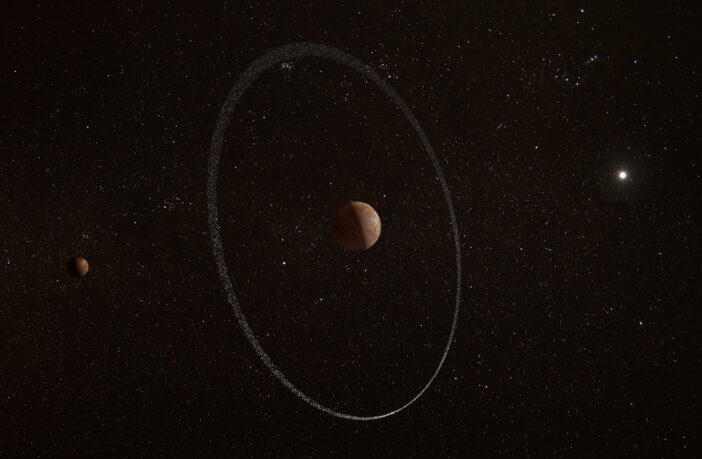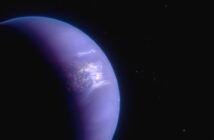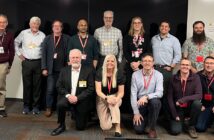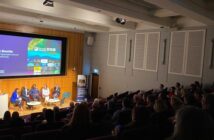An international team of astronomers, including Open University (OU) researchers, has discovered a ring around the distant dwarf planet Quaoar – a ring that should not exist. This questions our understanding of collision processes leading to the formation of planetary bodies, as reported in the 9 February 2023 issue of Nature.
Quaoar is an icy dwarf planet orbiting in the far reaches of the Solar System, 40 times more distant from the Sun than Earth, similar to Quaoar’s better-known cousin Pluto. Quaoar’s diameter is about 1100 km, about half that of Pluto.
An observational campaign between 2018 and 2021 of a group of large and small telescopes targeted Quaoar as it moved across the Sky, to catch it aligning perfectly with a more distant star. These so-called stellar ‘occultation events’ are akin to a solar eclipse where our Moon casts a shadow on Earth, while here Quaoar effectively casts a tiny shadow out of the light of the affected star.
As for total solar eclipses, the stellar occultation can only be seen from locations on Earth lucky enough to be in the very narrow visibility zone.
The OU’s PIRATE (the Physics Innovations Robotic Telescope Explorer) facility in Tenerife, a small robotic telescope used by OU students in the physical sciences curriculum as well as by OU researchers, happened to be in such a zone, and as a result the OU’s Ulrich Kolb and Richard Busuttil took part in this observing campaign.
Ulrich Kolb, Professor of Astronomy at the OU, said:
“Stellar occultations are a powerful tool for diagnosing the orbit and shape of small Solar System objects. The OU-owned robotic telescopes PIRATE and COAST (COmpletely Autonomous Service Telescope) in Tenerife are perfectly set up for observing such events. There is an element of luck involved, too: the observatory needs to be in the geographical zone where the occultation is observable, and it needs clear skies! On this occasion we were lucky and detected the occultation by Quaoar, and so did other observatories taking part in this collaborative effort.”
Recording the occulted star’s light change during the event unexpectedly revealed the existence of a debris ring around Quaoar, a feature similar to Saturn’s rings, but at a much smaller scale. What was most puzzling is that the ring is outside of the limit where such rings should exist, as seen in the Figure below.
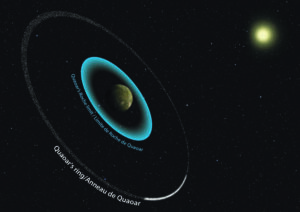
Artist’s impression of Quaor’s ring. The outer limit of the allowed zone for rings (the so-called Roche limit) is indicated in blue. Image credit: Paris Observatory.
This is because the ring particles would fairly quickly come closer together due to their own gravity and form a moon-like object. The fact that this ring doesn’t do that challenges our very understanding of the processes leading to the formation of small planetary bodies and ultimately of the Solar System as a whole, thus stimulating much theoretical research in this area.
Professor Kolb continued:
“The discovery of a ring was a bonus – but to find it effectively at the wrong place is truly exciting. The finding has already stimulated a great deal of numerical simulations trying to explain how the ring can survive intact. No doubt more detailed and alternative models will come forward. There is still a lot of question marks in our understanding of how the Solar System formed.”
This work perfectly illustrates how small robotic observatories like PIRATE, when operating in a network of facilities across the globe, can make vital contributions to astrophysical research.
PIRATE and COAST are the Tenerife facilities of the OpenScience Observatories, the astronomy wing of the OpenSTEM Labs. The OU is proud to facilitate practical science teaching for our distance learner’s skills with the very same facilities that contribute to cutting-edge research.
Professor Kolb added:
“I hope our physical sciences students will share some of my enthusiasm for the capability of a facility like PIRATE when they are using it in their studies. It doesn’t always take a hugely expensive space telescope to make exciting scientific contributions.”
The free OU course Astronomy with an online telescope includes access to COAST. OU modules which make use of PIRATE and COAST include SXPS288 Remote experiments in physics and space, S382 Astrophysics, the new S384 Astrophysics of stars and exoplanets, and S818 Space science.
This research was published as Morgado B.E. et al 2023, Nature, Vol 213, No 7946.
